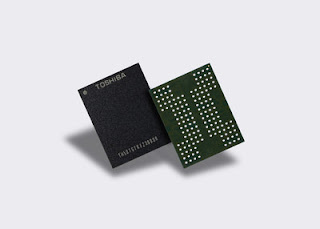Multi-level NAND flash is not a great technology for many embedded designs, but Toshiba has managed to stack 16 high density die into a package that stores 1.5Tbits of data.
The latest BiCS device uses a 4-bit-per-cell, quadruple-level cell (QLC) technology for the first time that enables larger die capacity than the company's third-generation 512Gb 3-bit-per-cell, triple-level cell (TLC), and pushes the boundaries of flash memory technology using a 64-layer stacked cell structure. This achieves the world's largest die capacity at 768Gbits/96GBytes. This is up from 128Gbytes in a package back in 2011.
The QLC flash memory also enables a 1.5-terabyte (TB) device with a 16-die stacked architecture in a single package, up 50% on the 1TByte package.
Increasing the number of bits-per-cell by one within the same electron count requires twice the accuracy of TLC technology, and Toshiba has combined its advanced circuit design and leading 3D flash memory process technology to overcome this challenge, successfully creating the world's first QLC 3D flash memory.
This could be especially beneficial for datacentre designs.
Increasing the number of bits-per-cell by one within the same electron count requires twice the accuracy of TLC technology, and Toshiba has combined its advanced circuit design and leading 3D flash memory process technology to overcome this challenge, successfully creating the world's first QLC 3D flash memory.
This could be especially beneficial for datacentre designs.
"The introduction of QLC technology sets the stage for solving many of the challenges facing datacentres today," said Greg Wong, founder and principal analyst at Forward Insights. "For datacentres, QLC SSDs can be an excellent design choice for reducing power consumption and lowering footprint. Additionally, as the push for higher capacity HDDs leads to an increase in areal density and drives up the weight per successive generation, it has become common to see a 42U rack only half-filled due to exceeding maximum weight or power supply. Flash memory-based storage solutions weigh less and give improved power efficiencies, enabling datacentres to achieve greater rack capacity."
"From SLC to MLC and MLC to TLC, large technology shifts are often met by industry resistance and the introduction of QLC is no exception," said Scott Nelson, senior vice president of Toshiba America's memory business unit, which competes with Samsung. "There will always be demand for compelling storage solutions that bring higher densities and produce a favourable cost/performance equation – our QLC technology falls squarely into that sweet spot. History has proven us right in the past when it comes to our visionary flash memory roadmap, and we fully expect QLC BiCS FLASH to continue our industry-leading track record."
Samples began shipping this month to SSD and SSD controller vendors for evaluation and development.
"From SLC to MLC and MLC to TLC, large technology shifts are often met by industry resistance and the introduction of QLC is no exception," said Scott Nelson, senior vice president of Toshiba America's memory business unit, which competes with Samsung. "There will always be demand for compelling storage solutions that bring higher densities and produce a favourable cost/performance equation – our QLC technology falls squarely into that sweet spot. History has proven us right in the past when it comes to our visionary flash memory roadmap, and we fully expect QLC BiCS FLASH to continue our industry-leading track record."
Samples began shipping this month to SSD and SSD controller vendors for evaluation and development.
Toshiba Memory Blog
Update - 30th June
Toshiba has also launched a new line of NVM Express (NVMeTM) solid state drives using the previous generation 64 layer 3D flash memories to provide up to 1TB capacity in a compact M.2 form factor.
Update - 30th June
Toshiba has also launched a new line of NVM Express (NVMeTM) solid state drives using the previous generation 64 layer 3D flash memories to provide up to 1TB capacity in a compact M.2 form factor.
This uses 3-bit-per-cell TLC (triple-level cell) (rather than 4bit) BiCS FLASH with PCI Express Gen3 x 4 lanes and NVMe Revision 1.2.1 to deliver up to 3000 MB/s of sequential read and 2100 MB/s of sequential write.
This compares to 6Gbit/s SATA storage, giving 5.4x sequential read performance and up to 3.8x sequential write performance with a maximum interface bandwidth of 32 GTransactions/s.
The XG5 also has an SLC cache to accelerate burst type workloads, such as those experienced routinely on Windows -based PCs, as well as improved standby power consumption reduced by over 50% to less than 3mW.
The XG5 Series SSDs will be available in three capacities, 256GB, 512GB and 1024GB, all on a single-sided M.2 2280 form factor. Self-encrypting drive (SED) models supporting TCG Opal Version 2.01 will also be offered. OEM customers will have access to limited quantities of qualification samples of the XG5 series, with shipments gradually increasing in the second half of 2017.
Related stories:
- Toshiba Launches Industry’s Largest Embedded NAND Flash Memory Modules (2010)
- Toshiba launches 19nm process NAND flash memory for 128Gbytes in a single package (2011)
- Shakeup in the top 20 semiconductor suppliers continues in 2016



No comments:
Post a Comment